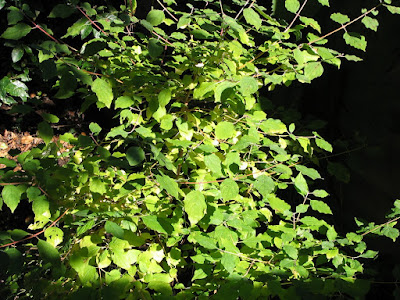So, if anyone asks you "What colour are Dogwood leaves?" what will you say?
And of course, one of the other attractive features of Dogwood is that even when all the leaves have fallen you will still have a glorious display of brightly-coloured stems, in various shades of red, yellow and orange. I'll be reporting on these later!
For those of you with more than a passing interest in the Dogwood family, these are the details of some of the varieties I have in my garden:
1. Cornus Sericea "Cardinal" - a large variety (grows to about 6 ft). Stems are multi-coloured red / yellow / orange.
2. Cornus Sanguinea "Midwinter Fire" - a compact variety (approx 3 ft), with small leaves, light green in Summer. Stems mostly yellowish-red.
3. Cornus Alba "Aurea" - height about 5 ft - leaves in Summer are a wonderful "acid yellow" colour, making a good contrast to darker shrubs like my Bronze Cotinus (Cotinus Coggyria "Royal Purple"). Stems bright red in Winter. My favourite one!
4. Cornus Alba "Gouchaultii" - height about 5 ft when mature - leaves variegated, green with yellow splashes. Stems not particularly impressive, yellowish.
I do also have a couple of other varieties, but I don't know their official names. For instance, one of them was propagated from some cuttings I took from some bushes at the side of a road. Since it came from near Milton Keynes, I call it "Cornus Milton Keynesii" ! It has mid-green Summer leaves and bright red Winter stems.
Incidentally, Dogwood is very easy to propagate from cuttings. I find that tearing off a small shoot (about 6 ins / 15cm long) with a "heel" of bark attached is better than literally cutting. I think the heel of bark has more growth hormones in it or something. You just push the cuttings into a pot of compost and leave them somewhere out of direct sunlight for a couple of months, watering occasionally, and most of them will start to grow. If you want, you can dip the cuttings in a commercial "Hormone Rooting Powder", but I'm not convinced that this is strictly necessary.



















A very beautiful plant. The white fruit looks great agains the red leaves.
ReplyDeleteSince moving to this garden and having time, along with the impetus of a blog to feed with photos has certainly motivated me to look very closely at what is here. I too have found amazing beauty in very common plants. That is why I like to take close photographs of parts of plants and flowers etc. I wonder if there is dogwood in Oz. I will try to find out.
ReplyDeleteLovely range of pictures, Mark. I love the dogwoods, especially in the winter when they really come into their own. The winter gardens at Anglesey Abbey are a stunning example. I'm a particular fan of the Midwinter Fire - think my mum has made some cuttings of her one for us, as soon as we have somewhere to put them!
ReplyDeleteLovely pics Mark - isn't it funny how blogging about your garden makes you take more notice of it, and in details too, because of taking so many photos? I'm finding it a very welcome side effect.
ReplyDeleteI used to think of vegetables just as a food. But starting my garden and raising my vegetables could change the idea perfectly. I came to see vegetables as living creatures. I believe you see the dogwoods, which were so common plants that you were not able to recognize their beauty, as beautiful.
ReplyDeleteI wonder if we have this plant in America? If so, it must be called something else. The only Dogwood I am familiar with in U.S is a tree with beautiful flowers in Spring, either pink or white. It is said that the Dogwood tree was used for the cross that Jesus died on, and after that never grew so very large. I find learning about the plants there very interesting and your photograhy is surperb.
ReplyDelete